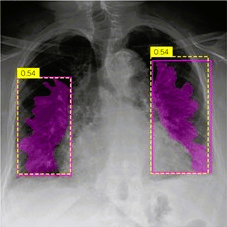Explainable AI for Medical Image Analysis, a Case Study
Pulmonary Edema: Why Severity Assessment is Critical
Pulmonary edema, an excessive presence of fluid in the lungs, is a leading cause in patients with congestive heart failure (CHF) requiring
Challenges within Radiographic Imaging
Radiographic imaging plays a crucial role in this assessment, where radiologists adopt categorical grading scales to assess the degree of severity. However, the accurate quantification of radiographic images is both time-intensive and highly variable among radiological experts, meaning optimal patient care is often delayed before a consensus on the treatment plan can be reached.

Machine Learning Methods to Overcome Such Challenges
The application of computerized methods to streamline the assessment of radiographic imaging has been a topic of intense research for quite some time. Furthermore, the recent advancement in ML methods provides a novel way of tackling this assessment problem at hand. In particular, isolating and highlighting regions of an image that an ML model considers important in its decision-making could significantly accelerate the process of reaching a consensus amongst experts.
Limitations of Machine Learning Methods
However, the quest to develop
Despite this, several attempts have been made to develop explainable ML models for radiographic image assessment, with the development of explanation techniques for ML models also gaining traction.
Towards an Explainable AI Solution
In our recent pilot study, Quantori introduces a two-stage workflow that detects radiographic features associated with pulmonary edema, particularly cephalization, Kerley lines, pleural effusion, bat wings, and infiltrates.
The initial stage isolates the lung area within a radiographic image, ensuring that future decision-making focuses solely on the regions of interest. The subsequent stage focuses on the detection of edema-related features. However, each pulmonary edema feature is highly distinct from the rest, meaning developing a global solution would require a complex and bloated model exceeding realistic limits for use in real-life clinical settings.
 Radiological features of pulmonary edema: Cephalization: cyan polylines; Kerley lines: green lines; Pleural effusions: purple masks; Infiltrates: blue masks; Bat wings: yellow masks
Radiological features of pulmonary edema: Cephalization: cyan polylines; Kerley lines: green lines; Pleural effusions: purple masks; Infiltrates: blue masks; Bat wings: yellow masks
To overcome such limitations, Quantori developed a modular approach where each edema feature would be detected by a distinct model. To achieve this, multiple standard ML models were tested, with special attention given to model size (measured in terms of model parameters). A thorough assessment of different architecture pitfalls and model performance was provided. This ensures that trade-offs between model performance and feasibility of application in a real-life setting can be assessed.
Our study represents a first step in the complex endeavor of developing a smart medical assistant. The modular nature of the work, as well as an

